人教版小学英语总复习资料
- 格式:doc
- 大小:22.50 KB
- 文档页数:3
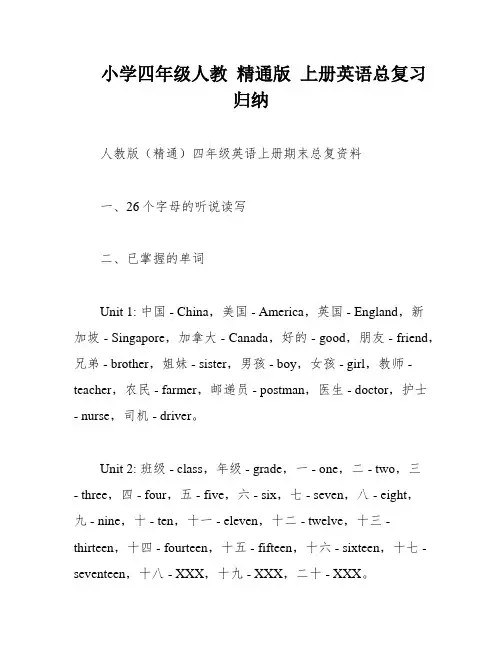
小学四年级人教精通版上册英语总复习归纳人教版(精通)四年级英语上册期末总复资料一、26个字母的听说读写二、已掌握的单词Unit 1: 中国 - China,美国 - America,英国 - England,新加坡 - Singapore,加拿大 - Canada,好的 - good,朋友 - friend,兄弟 - brother,姐妹 - sister,男孩 - boy,女孩 - girl,教师 - teacher,农民 - farmer,邮递员 - postman,医生 - doctor,护士- nurse,司机 - driver。
Unit 2: 班级 - class,年级 - grade,一 - one,二 - two,三- three,四 - four,五 - five,六 - six,七 - seven,八 - eight,九 - nine,十 - ten,十一 - eleven,十二 - twelve,十三 - thirteen,十四 - fourteen,十五 - fifteen,十六 - sixteen,十七 - seventeen,十八 - XXX,十九 - XXX,二十 - XXX。
Unit 3: 菠萝 - pineapple,柠檬 - lemon,苹果 - apple,梨 - pear,西瓜 - watermelon,猕猴桃 - kiwi fruit,橙 - orange,香蕉 - banana,土豆 - potato,番茄 - tomato,胡萝卜 - carrot,黄瓜 - cucumber,茄子 - eggplant,青椒 - green pepper。
Unit 4: 晴朗的 - fine,好的 - nice,温暖的 - warm,凉爽的 - cool,炎热的 - hot,寒冷的 - cold,晴朗的 - sunny,多云的 - cloudy,有风的 - windy,下雨的 - rainy,下雪的 - XXX。
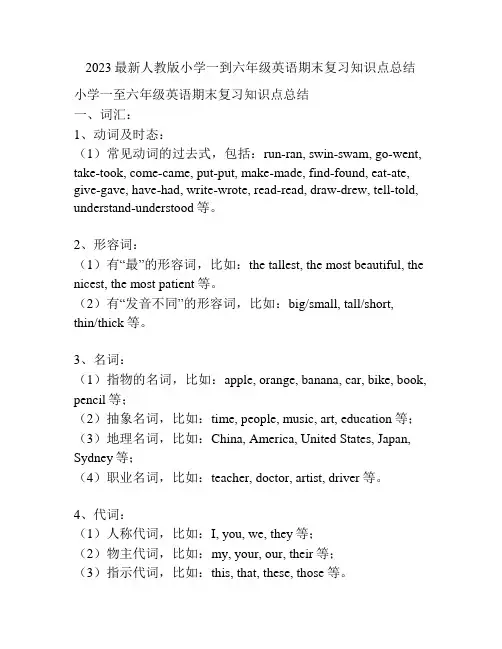
2023最新人教版小学一到六年级英语期末复习知识点总结小学一至六年级英语期末复习知识点总结一、词汇:1、动词及时态:(1)常见动词的过去式,包括:run-ran, swin-swam, go-went, take-took, come-came, put-put, make-made, find-found, eat-ate, give-gave, have-had, write-wrote, read-read, draw-drew, tell-told, understand-understood等。
2、形容词:(1)有“最”的形容词,比如:the tallest, the most beautiful, the nicest, the most patient等。
(2)有“发音不同”的形容词,比如:big/small, tall/short,thin/thick等。
3、名词:(1)指物的名词,比如:apple, orange, banana, car, bike, book, pencil等;(2)抽象名词,比如:time, people, music, art, education等;(3)地理名词,比如:China, America, United States, Japan, Sydney等;(4)职业名词,比如:teacher, doctor, artist, driver等。
4、代词:(1)人称代词,比如:I, you, we, they等;(2)物主代词,比如:my, your, our, their等;(3)指示代词,比如:this, that, these, those等。
5、冠词:(1)不定冠词a/an;(2)定冠词the,在某些情况下可以省略,如:At weekend.6、介词:(1)时间介词,比如:in, on, at;(2)地点介词,比如:to, from;(3)方式介词,比如:by, with;(4)其他介词,比如:of, for, like, under, behind等。
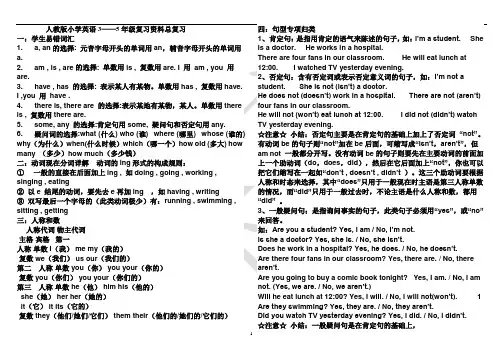
人教版小学英语3——5年级复习资料总复习一:学生易错词汇1. a, an的选择: 元音字母开头的单词用an,辅音字母开头的单词用a.2. am , is , are的选择: 单数用is , 复数用are. I 用am , you 用are.3. have , has 的选择: 表示某人有某物。
单数用has , 复数用have.I ,you 用have .4. there is, there are 的选择:表示某地有某物,某人。
单数用there is , 复数用there are.5. some, any 的选择:肯定句用some, 疑问句和否定句用any.6. 疑问词的选择:what (什么) who (谁) where (哪里) whose (谁的) why(为什么)when(什么时候)which(哪一个)how old (多大) how many (多少)how much(多少钱)二:动词现在分词详解动词的ing形式的构成规则:①一般的直接在后面加上ing , 如doing , going , working ,singing , eating②以e 结尾的动词,要先去e再加ing,如having , writing③双写最后一个字母的(此类动词极少)有:running , swimming , sitting , getting三:人称和数人称代词物主代词主格宾格第一人称单数 I(我) me my(我的)复数 we(我们) us our(我们的)第二人称单数 you(你) you your(你的)复数 you(你们) you your(你们的)第三人称单数 he(他) him his(他的)she(她) her her(她的)it(它) it its(它的)复数 they(他们/她们/它们) them their(他们的/她们的/它们的)四:句型专项归类1、肯定句:是指用肯定的语气来陈述的句子,如:I’m a student.She is a doctor. He works in a hospital.There are four fans in our classroom. He will eat lunch at 12:00. I watched TV yesterday evening.2、否定句:含有否定词或表示否定意义词的句子,如:I’m not a student. She is not (isn’t) a doctor.He does not (doesn’t) work in a hospital.There are not (aren’t) four fans in our classroom.He will not (w on’t) eat lunch at 12:00.I did not (didn’t) watch TV yesterday evening.☆注意☆小结:否定句主要是在肯定句的基础上加上了否定词“not”。
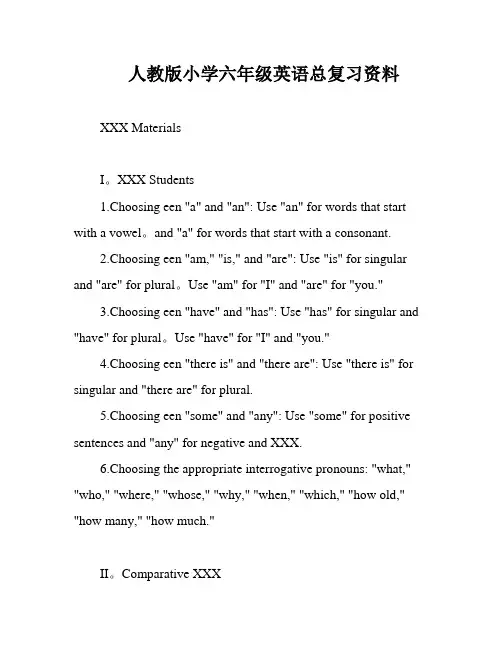
人教版小学六年级英语总复习资料XXX MaterialsI。
XXX Students1.Choosing een "a" and "an": Use "an" for words that start with a vowel。
and "a" for words that start with a consonant.2.Choosing een "am," "is," and "are": Use "is" for singular and "are" for plural。
Use "am" for "I" and "are" for "you."3.Choosing een "have" and "has": Use "has" for singular and "have" for plural。
Use "have" for "I" and "you."4.Choosing een "there is" and "there are": Use "there is" for singular and "there are" for plural.5.Choosing een "some" and "any": Use "some" for positive sentences and "any" for negative and XXX.6.Choosing the appropriate interrogative pronouns: "what," "who," "where," "whose," "why," "when," "which," "how old," "how many," "how much."II。
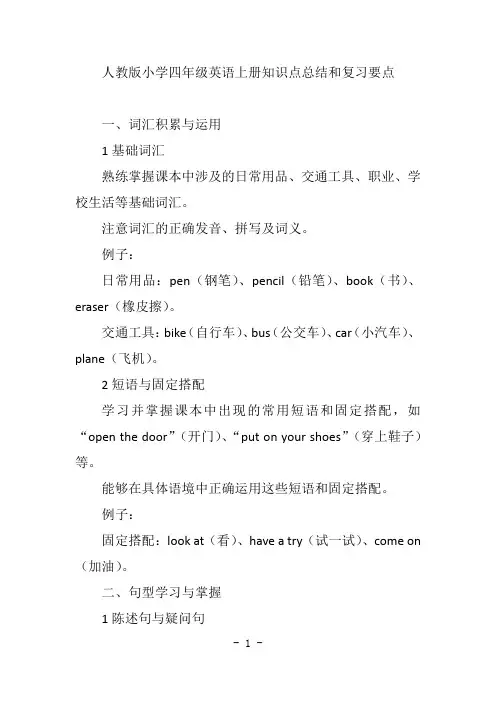
人教版小学四年级英语上册知识点总结和复习要点一、词汇积累与运用1基础词汇熟练掌握课本中涉及的日常用品、交通工具、职业、学校生活等基础词汇。
注意词汇的正确发音、拼写及词义。
例子:日常用品:pen(钢笔)、pencil(铅笔)、book(书)、eraser(橡皮擦)。
交通工具:bike(自行车)、bus(公交车)、car(小汽车)、plane(飞机)。
2短语与固定搭配学习并掌握课本中出现的常用短语和固定搭配,如“open the door”(开门)、“put on your shoes”(穿上鞋子)等。
能够在具体语境中正确运用这些短语和固定搭配。
例子:固定搭配:look at(看)、have a try(试一试)、come on (加油)。
二、句型学习与掌握1陈述句与疑问句熟练掌握陈述句和疑问句的基本结构,能够正确运用主语、谓语和宾语。
学会使用疑问句询问信息,如“What’s this?”(这是什么?)和“Where is your book?”(你的书在哪里?)。
例子:陈述句:I have a new pencil box.(我有一个新的铅笔盒。
)疑问句:Do you like playing football?(你喜欢踢足球吗?)2特殊疑问句学习并掌握“What color is it?”(它是什么颜色的?)、“How old are you?”(你多大了?)等特殊疑问句及其回答方式。
能够根据问题提供正确的信息。
例子:特殊疑问句:What do you usually do on weekends?(你周末通常做什么?)回答:I usually go to the park with my family.(我通常和家人去公园。
)三、语音与语调规则1元音与辅音发音复习并巩固元音和辅音的发音规则,注意发音的准确性和清晰度。
练习发音相近或容易混淆的词汇,提高发音敏感度。
发音练习:正确区分“thin”(瘦的)和“thing”(事情)的发音。
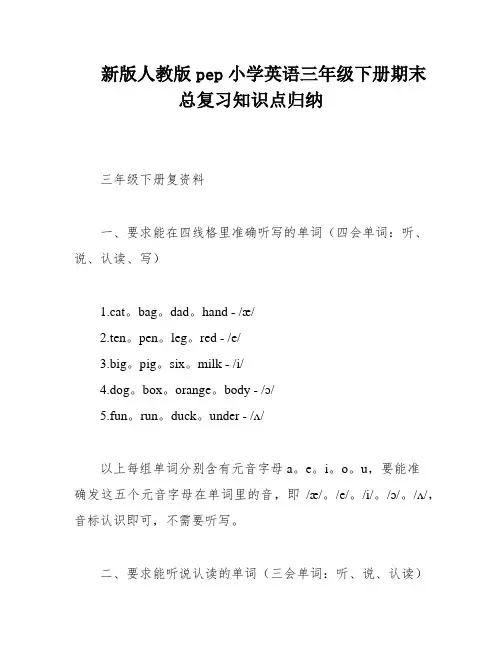
新版人教版pep小学英语三年级下册期末总复习知识点归纳三年级下册复资料一、要求能在四线格里准确听写的单词(四会单词:听、说、认读、写)1.cat。
bag。
dad。
hand - /æ/2.ten。
pen。
leg。
red - /e/3.big。
pig。
six。
milk - /i/4.dog。
box。
orange。
body - /ɔ/5.fun。
run。
duck。
under - /ʌ/以上每组单词分别含有元音字母 a。
e。
i。
o。
u,要能准确发这五个元音字母在单词里的音,即/æ/。
/e/。
/i/。
/ɔ/。
/ʌ/,音标认识即可,不需要听写。
二、要求能听说认读的单词(三会单词:听、说、认读)Unit 1 e back to school!the) UK。
Canada。
(the) USA。
China英国、加拿大、美国、中国she。
he。
student。
teacher。
pupil她、他、学生、教师、小学生Unit 2 My familyfather (dad)。
man。
mother (mum)。
woman爸爸、男人、妈妈、女人sister。
brother。
grandfather (grandpa)。
grandmother (grandma)姐妹、兄弟、爷爷或外公、奶奶或外婆Unit 3 At the zoo括号里的称呼都是前面正式称呼的口头称呼,用于口头交流。
国家首字母要大写,缩写国家前加the,注意the 的发音。
fat。
thin。
tall。
short - 胖的、瘦的、高的、矮的small。
big。
long。
short - 小的、大的、长的、短的Unit 4 Where is my car?本单元都是形容词,可以用It’s… 来表达;表示长度时用long。
short;表示高度时用 tall。
short;注意区分应用 short 的两种不同意思。
in。
on。
under。
chair。
desk - 在…里、在…上、在…下面、椅子、桌子cap。
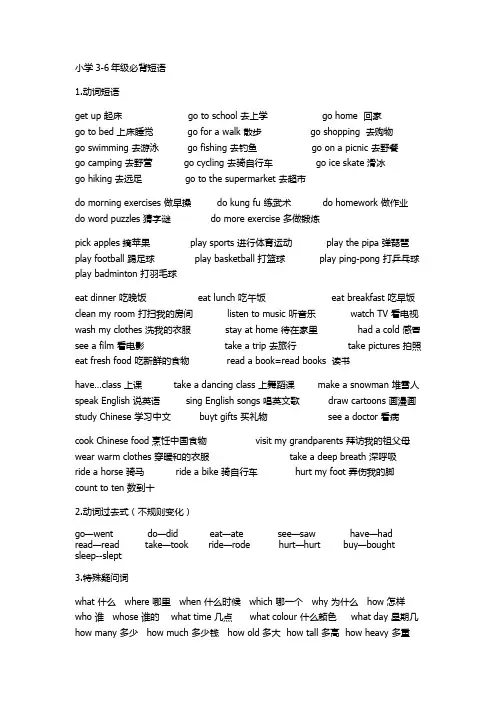
小学3-6年级必背短语1.动词短语get up 起床 go to school 去上学 go home 回家go to bed 上床睡觉 go for a walk 散步 go shopping 去购物go swimming 去游泳 go fishing 去钓鱼 go on a picnic 去野餐go camping 去野营 go cycling 去骑自行车 go ice skate 滑冰go hiking 去远足 go to the supermarket 去超市do morning exercises 做早操 do kung fu 练武术 do homework 做作业do word puzzles 猜字谜 do more exercise 多做锻炼pick apples 摘苹果 play sports 进行体育运动 play the pipa 弹琵琶play football 踢足球 play basketball 打篮球 play ping-pong 打乒乓球play badminton 打羽毛球eat dinner 吃晚饭 eat lunch 吃午饭 eat breakfast 吃早饭clean my room 打扫我的房间 listen to music 听音乐 watch TV 看电视wash my clothes 洗我的衣服 stay at home 待在家里 had a cold 感冒see a film 看电影 take a trip 去旅行 take pictures 拍照eat fresh food 吃新鲜的食物 read a book=read books 读书have…class 上课 take a dancing class 上舞蹈课 make a snowman 堆雪人speak English 说英语 sing English songs 唱英文歌 draw cartoons 画漫画study Chinese 学习中文 buyt gifts 买礼物 see a doctor 看病cook Chinese food 烹饪中国食物 visit my grandparents 拜访我的祖父母wear warm clothes 穿暖和的衣服 take a deep breath 深呼吸ride a horse 骑马 ride a bike 骑自行车 hurt my foot 弄伤我的脚count to ten 数到十2.动词过去式(不规则变化)go—went do—did eat—ate see—saw have—had read—read take—took ride—rode hurt—hurt buy—bought sleep--slept3.特殊疑问词what 什么 where 哪里 when 什么时候 which 哪一个 why 为什么 how 怎样who 谁 whose 谁的 what time 几点 what colour 什么颜色 what day 星期几how many 多少 how much 多少钱 how old 多大 how tall 多高 how heavy 多重一、写出你的周末、暑假计划:一般将来时be going to+动词原形例文1:Summer holiday is coming.I have a nice plan.The first week,I am going to stay at home to finish my homework and watchTV.Then,my family and I are going to Yunnan.We are going to visit Lijiang and Shangri-la.At last,I am going to the countryside and stay with my grandparents.I can go fishing there.I think I will have a very happy holiday.二、写写你上周末你做了什么:一般过去时例文2:My weekendI was busy last weekend.On Saturday morning,I cleaned my room and washed my clothes,then I went fishing with my father.In the afternoon,I read some books and did my homework.On Sunday morning,I saw a film with my mother.We visited my grandparents in the afternoon.We watched TV in the evening and went to bed at 10:00.。
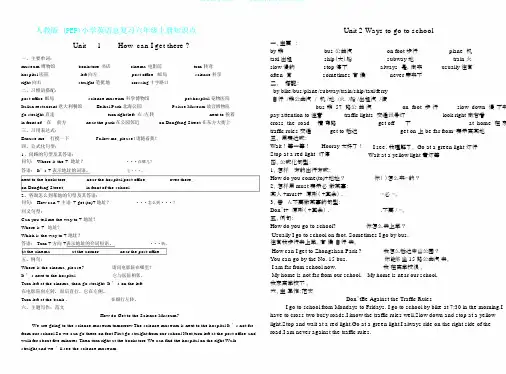
人教版 (PEP)小学英语总复习六年级上册知识点Unit1How can I get there ?一、主要单词:museum 博物馆bookstore 书店cinema 电影院turn 转弯hospital 医院left 向左post office邮局science 科学right 向右straight 笔挺地crossing 十字路口二、习惯语搭配:post office 邮局science museum 科学博物馆pet hospital 宠物医院Italian restaurant 意大利餐馆Beihai Park 北海公园Palace Museum 故宫博物院go straight 直走turn right/left 右 /左转next to 挨着in front of... 在 ...前方near the park 在公园邻近on Dongfang Street 在东方大街上三、习用表达式:Unit 2 Ways to go to school一、主要:by 乘bus 公共汽on foot 步行plane 机taxi 出租ship(大)船subway 地train 火slow 慢的stop 停下always 是,向来usually 往常often 常sometimes 有候never 素来不二、搭配:by bike/bus/plane/subway/train/ship/taxi/ferry自行 /乘公共汽 / 机 /地 /火 /船 /出租汽 /渡bus 乘 57 路公共汽on foot 步行slow down 慢下来pay attention to 注意traffic lights 交通讯号灯look right 向右看cross the road横穿路get off下at home 在家traffic rules 交通get to 抵达get on 上be far from⋯表示离某地Excuse me打搅一下Follow me, please! 请随着我!四、公式化句型:1、问路的句型及其答语:问句: Where is the + 地址?···在哪儿?答语: It’s + 表示地址的词语。
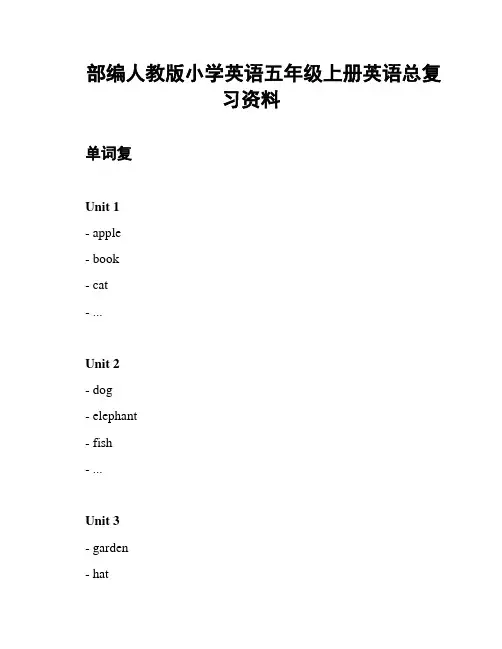
部编人教版小学英语五年级上册英语总复习资料单词复Unit 1- apple- book- cat- ...Unit 2- dog- elephant- fish- ...Unit 3- garden- hat- ice cream- ...句子练1. I have a red pen.2. She likes to dance.3. They are playing soccer.语法总结- 过去式的构成:动词+ed- 一般疑问句的结构:助动词+主语+动词- ...口语练请根据以下问题进行口语练:1. What's your name?2. How old are you?3. Where do you live?阅读练请阅读以下短文并回答问题:I have a pet dog. Its name is Max. Max is very fluffy and friendly. It likes to play fetch and go for walks. Max is 3 years old. I love Max very much.1. What is the name of the pet dog in the story?2. How old is Max?3. What does Max like to do?研究建议- 制定研究计划,每天复一些单词和句子。
- 多与他人进行口语练,提高语言表达能力。
- 阅读英语短文,加强阅读理解能力。
总结本文档提供了部编人教版小学英语五年级上册的英语总复习资料,包括单词复习、句子练习、语法总结、口语练习、阅读练习和学习建议。
通过使用这些资料,学生可以巩固所学知识,提高英语水平。
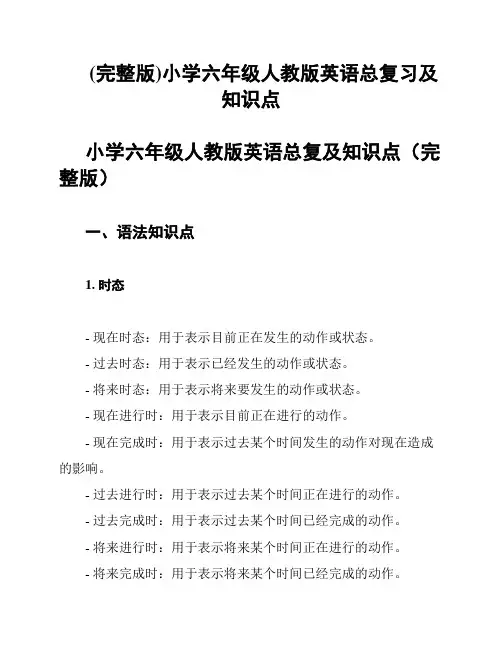
(完整版)小学六年级人教版英语总复习及知识点小学六年级人教版英语总复及知识点(完整版)一、语法知识点1. 时态- 现在时态:用于表示目前正在发生的动作或状态。
- 过去时态:用于表示已经发生的动作或状态。
- 将来时态:用于表示将来要发生的动作或状态。
- 现在进行时:用于表示目前正在进行的动作。
- 现在完成时:用于表示过去某个时间发生的动作对现在造成的影响。
- 过去进行时:用于表示过去某个时间正在进行的动作。
- 过去完成时:用于表示过去某个时间已经完成的动作。
- 将来进行时:用于表示将来某个时间正在进行的动作。
- 将来完成时:用于表示将来某个时间已经完成的动作。
2. 语法结构- 名词:用于表示人、动物、物体、地点等。
- 动词:用于表示动作或状态。
- 形容词:用于描述名词的特征或状态。
- 副词:用于修饰动词、形容词或其他副词。
- 介词:用于表示位置、时间或关系等。
- 代词:用于替代名词。
- 数词:用于表示数量。
- 冠词:用于限定名词的范围。
- 连词:用于连接词语、短语或句子。
3. 句子结构- 主语:句子中执行动作或承受动作的人或事物。
- 谓语:句子中说明主语动作或状态的部分。
- 宾语:句子中接受动作的人或事物。
- 定语:用于修饰名词或代词的成分。
- 状语:用于修饰动词、形容词、副词或整个句子的成分。
- 表语:用于说明主语的状态或特征的部分。
二、总复内容1. 单词- 请根据教材中的单词表,复并牢记相关的单词拼写和意思。
2. 句子- 复教材中的对话和句子,理解并掌握其基本意思和用法。
3. 对话- 复教材中的对话,掌握其中的日常生活用语和表达方式。
4. 语法- 复教材中的语法知识点,加深对时态、语法结构和句子成分的理解。
三、研究方法1. 多听多说- 多听英语教材、歌曲或英语广播,提高听力水平。
- 多说英语,练口语表达和语音准确性。
2. 多读多写- 多读英语教材、故事书等,提高阅读理解能力。
- 多写英语作文,锻炼自己的写作能力和语法运用。
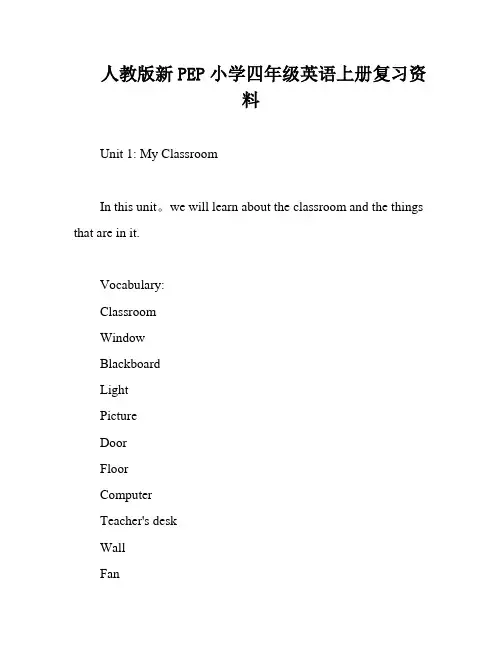
人教版新PEP小学四年级英语上册复习资料Unit 1: My ClassroomIn this unit。
we will learn about the classroom and the things that are in it.Vocabulary:ClassroomWindowBlackboardLightPictureDoorFloorComputerTeacher's deskWallFanNearReallyTVCleanHelpLet's Spell:A-E [ei]: cake。
face。
name。
make。
hateA [æ]: cat。
dad。
hat。
cap。
mapSentence Structures:1.We have a new classroom.2.Let's go and see.3.What's in the classroom?4.One blackboard。
one TV。
many desks and chairs.5.Where is it?6.It's near the window.7.It's so big.8.Let's clean the classroom.9.Let me clean the windows.10.Look。
This is the new classroom。
The door is orange.Phrases:1.n: on the wall。
near the window。
in the classroom。
on the fan。
near the computer2.n: clean the desks and chairs。
clean the windows。
cleanthe fishbowl。
open the door。
turn on the light。
人教版小学六年级英语总复习资料人教版小学六年级英语总复习资料 ,3-6年级句子单词,三年级上册单词黑体字(73个单词)pen pencil pencil-case book bag ruler eraser crayon sharpener schoolhead face nose mouth eye ear arm hand finger leg foot body red yellow green blue purple white black orange pink brown cat dog monkey panda rabbit ducksquirrel mouse elephant pig bird bear cake bread hot dog hamburger chicken French friesCoke juice milk water tea coffee one two three four five six seven eight nine ten doll ball boat kite balloon car plane 三年级下册单词黑体字,72个单词、词组,boy girl teacher student this my friend nice good morning goodafternoon meet goodbye too I’m=Iamfather dad mother mom man woman grandmother grandma grandfather grandpa sister brother let’s=letus really great and howeleven twelve thirteenfourteen fifteen sixteen seventeen eighteen nineteen twenty how many can lookat peach pear orange watermelon apple banana grape strawberry like some thanks bus bike taxi jeepdesk chair walkman lamp your zoosmall big long short tall giraffe deer四年级上册单词黑体字,66个单词、词组,window board light picture doorfloor classroom computer wall fan teacher’s desk Chinese book Englishbook math book schoolbag story-book notebook twenty-one thirty thirty-one forty forty-one fifty long hair shorthair thin strong quiet friend(s) music science sports computer game painting study bathroom bedroom living kitchen phone bed sofa shelf fridge table rice fish noodles beef vegetable soup knife chopsticks spoon plate fork family parents uncle aunt babydriver doctor farmer nurse baseball player 四会单词,36个,bag pencil pen book ruler pencil-case teacher student boy girl friend home room school classroom window desk door chair bed rice beef bread milk egg waterchicken fishsister brother father mother driver doctor farmer nurse四年级下册单词黑体词,50个单词、词组,playground garden teacher’s desk canteen art room computerroom washroom music roomgym TV room lunch English class music class breakfast dinner P.E. class get up go to school go home go to bed sweater jeans pants socks shoes shorts hot weather rainy windy cloudy colourfulpretty cheap expensive sneakers slippers sandals boots sheep hen lamb goat cow tomato cucumber potato onion carrot 四会单词,88个, computer board fan light this is my that your teacher’sdesk picture wall floor yes it one two three four five six seven eightnine ten what time it’s o’clock mathChinese English P.E. music for classjacket shirt skirt dress T-shirt redblue yellow green white no not colourwarm cold cool today jeans pant socks shoes let’s play football snowy sunny how much big small long short applebanana pear orange watermelon are theyhorse aren’t cat rabbit pig duck dogeleven twelve thirteen fifteen twenty how many there 五年级上册单词黑体字,16个单词、词组,principal university student cabbage pork mutton empty the trash put away the clothes air-conditioner over in front of sky cloud mountain village city四会单词、词组,93个,young funny tall strong kind old short thin who’s=whois Mr what’s=what is like he’s=he is strict smart active quiet she’s=sheis very but Monday Tuesday Wednesday Thursday Friday day have on Saturday Sunday do homework watch TV read books What about…? Too eggplant fish greenbeans tofu potato tomato for lunch we tasty sweet sour fresh saltyfavourite they’re=they are fruit don’t=do not grape cook the meals waterthe flowerssweep the floor clean the bedroom make the bed set the table wash the clothes do the dishescan’t=cannot use a computer curtain trashbin closet mirror end table bedroom kitchen bathroom livingroom in on under near behind clothes riverflower grass lake forest path parkpicture house bridge tree road building clean五年级下册单词黑体字,18个,January February March April May JuneJuly August September October NovemberDecember first second third fourth fifth Eighth ninth twelfth twentieth 四会单词、词组,83个,do morning exercises eat breakfast have English class play sports eat dinner when eveningget up at usually noon climb mountains go shopping play the piano visit grandparentsgo hiking weekend often sometimes spring summer fall winter season which best swimfly kites skate make a snowman plant trees why because sleep Jan. Feb. Mar. Apr. May June July Aug.Sept. Oct. Nov. Dec. birthday uncle her datedraw pictures cook dinner read a book answer the phone listento music clean the roomwrite a letter write an e-mail mom grandpa studyfly jump walk run swim kangaroosleep climb fight swing drink water take pictures watch insects pick up leavesdo an experiment catch butterflies honey count insects collect leaves write a report play chess have a picnic六年级上册单词黑体字,16个,plane ship subway science museum northsouth east west tonight tomorrowtake a trip read a magazine go to the cinema magazinedictionary vapour 四会单词、词组,71个,by foot bike bus train how go to school traffic traffic light traffic rule stop wait get to library post office hospital cinema bookstore where please nest to turn right left straight then next week this morning this afternoon this evening comic book post card newspaper buy hobby ride a bike dive play the violin make kites collectstamps live(s) teach(es) go(es) watch(es)read(s) doesdoesn’t=doesnot singer writer actor actressartist TV reporter engineer accountant policeman salesperson cleaner where work raincloud sun stream seed come from soil sprout plant should then 六年级下册单词四会单词,25个,taller shorter stronger older younger biggerheavier longer thinner smaller have a fever hurt have a cold have a toothache have a headache have a sore throat matter sore nose tired excited angry happy bored sad三年级上册句子读下列句子,写出中文意思.1. Hello! ___________ Hi! _____________________________2. Hello! I’m Wu Yifan. I’m fromChina.__________________________3. What’s your name?_______________________________________4. My name’s Chen Jie. ______________________________________5. I have a pencil. ____________________ Metoo._________________ 6. Good morning._______________ Good afternoon._______________ 7. This is Miss White. _____________Nice to meet you. ____________ 8. Where are you from? ____________ I’m from America.___________9. Let’s go to school. __________________ OK.,,,,,,,,10. . How many cakes? ____________________One cake.__________11. How are you? ________________I’m fine, thankyou._____________12. Let’s paint. _________________Great.________________________13. I like green._________________ Me too.______________________ 14. I have a rabbit.___________________________________________ 15. Cool! ________ Super!_________ Great!________ Wow!_________ 16. May I have a look? ___________________Sure. _________________ 17. Here you are._________Thank you. __________You’re welcome18. I like hamburgers._______________ Me too.___________________ 19. Have some French fries.____________________________________ 20. Can I have some chicken?____________________Sure. __________ 21. How old are you?____________________ I’m nine. ____________三年级下册句子1. Where are you from? I’m from America.2. Good morning! Good afternoon!3. Class, we have a new friend today.4. Who’s that woman? She’s my mother。
PEP新版三年级上册复习资料pen (钢笔) pencil (铅) pencil-box ( 铅笔盒) ruler(尺子) eraser(橡皮) crayon (蜡笔) book (书) bag (书包) no(不)your(你的)red (红色的) yellow (黄色的)green (绿色的) blue (蓝色的) purple (紫色的) white (白色的) black (黑色的) orange (橙色的) pink (粉色的)brown (棕色的) ok 好,行mum 妈妈head (头) face( 脸) nose (鼻子) mouth (嘴) eye (眼睛)leg (腿) ear (耳朵) arm (胳膊)leg (腿)foot (脚)body (身体) school (学校)cat (猫)dog (狗)monkey (猴子)panda (熊猫) duck (鸭子)pig (猪)bird (鸟) bear (熊)elephant (大象)tiger(老虎)zoo(动物园)funny(滑稽的,好笑的)cake (蛋糕)bread (面包) juice (果汁) milk (牛奶) water (水) egg(蛋)fish(鱼)rice(米饭)one (一) two (二) three (三)four (四)five (五)six( 六)seven (七) eight (八) nine( 九)ten( 十)brother(兄,弟)plate盘子二.牢记下面的对话,会让你的英语说得更棒!(A是上句,B是答句)Unit 11、向别人问好应该说――A: Hello! (你好!) B: Hi! (你好!)2、问别人的名字应该说-――A:What’s your name?你叫什么名字?B:My name’s Chen Jie. 我的名字是陈洁。
3跟别人分手应A: Bye.\ Good bye!(再见) B: See you.(再见) \ Goodbye.(再见)4 A: I have a ruler\an eraser 我有一把尺子\ 一块橡皮。
精心整理人教版(PEP)小学英语总复习六年级上册知识点Unit1Howcan I getthere? 一、主要单词:museum 博物馆bookstore 书店cinema 电影院turn 转弯:sciencemuseum talianrestaurantExcuseme 打扰一下 1Whereisthe+nexttothebookstore,nearthehospital/postoffice,overthere,I t’s+表示地点的词语。
它···。
2Howcan+主语+get(to)+the+Canyoutellmethewayto+Whereis+Whichisthewayto+Turn+方向+表示地点的介词短语。
atthecinemaatthecornernearthepostoffice...Whereisthecinema,please?I t’snexttothehospital.它与医院相邻。
Turnleftatthecinema,thengostraight.I t’sontheleft.在电影院向1、Whereisthemuseumshop?博物馆商店在哪里?I t’snearthedoor.他在门附近。
2、Whereisthepostoffice?邮局在哪里?I t’snexttothemuseum.它与博物馆相邻。
3、Whereistherestaurant?餐馆在哪里?I t’snexttothetheparkonDongfangStreet.它与东方街上的公园相邻。
Unit2Waystogotoschoolby乘bus公共汽车onfoot步行plane飞机taxi出租车ship subway地铁train火车slow慢的stop停下always usually通常often经常sometimes有时候never从来不,永不Wait Hooray I see.绿灯行Stopataredlight红灯停Waitatayellowlight1Howdoyoucome(to)+2、如何用must某人+must++.···必须···。
PEP三年级下册期末总复习知识重点及习题【单词】Unit 1UK 英国Canada 加拿大USA 美国China 中国boy 男孩girl 女孩teacher 教师student 学生pupil 小学生my 我的friend 朋友and 和,与new 新的today 今天Unit 2father 父亲;爸爸dad 爸爸mother 母亲;妈妈mom 妈妈man 男人woman 女人grandmother 外/祖母grandma 外/祖母grandfather(外)祖父grandpa (外)祖父sister 姐妹brother 兄弟let’s=let us 让我们Unit 3thin 瘦的fat 胖的small 小的big 大的long 长的tall 高的short 短的;矮的giraffe长颈鹿deer 鹿lion 狮子wolf 狼fox 狐狸zebra 斑马horse 马gorilla 猩猩so 这么,那么tail 尾巴children 儿童Unit 4in 在……里面on在……上面under在……下面behind在……后面desk 课桌chair 椅子car 小汽车boat 船jeep 吉普车ball 球map 地图cap 帽子toy 玩具box 盒,箱balloom 气球table 桌子bed 床can 能can’t 不能dollar 美元Unit 5pear 梨orange 橙子watermelon 西瓜apple 苹果banana 香蕉strawberry草莓grape 葡萄peach 桃buy 买fruit 水果chicken 鸡肉hot dog 热狗Unit 6eleven 十一twelve 十二thirteen 十三fourteen 十四fifteen 十五sixteen 十六seventeen 十七eighteen 十八nineteen 十九twenty 二十beautiful 美丽的kite 风筝finger 手指toe 脚趾【句型】Unit 1Welcome back! 欢迎回来!Nice to see you again. 很高兴再次见到你。
小学五年级上册人教版英语复习资料汇总小学五年级人教版英语复习资料一、单词复习1.动物类单词:cat猫,dog狗,pig猪,elephant大象,monkey猴子,panda熊猫,lion狮子,tiger老虎,cow牛,sheep羊,goat山羊,chicken鸡,duck鸭子。
2.水果类单词:apple苹果,banana香蕉,orange橙子,grape葡萄,watermelon西瓜,pineapple菠萝,pear梨子,peach桃子。
3.家具类单词:chair椅子,table桌子,desk书桌,bed床,bookshelf书架,drawer抽屉,sofa沙发。
4.食品类单词:rice米饭,noodles面条,bread面包,beef牛肉,pork猪肉,fish鱼肉,egg蛋。
5.季节类单词:spring春天,summer夏天,autumn秋天,winter冬天。
二、词组复习1.关于动物:feed the pigs喂猪,milk the cows挤牛奶,tame the狮子驯狮子。
2.关于水果:peel the orange剥橙子,cut the watermelon切西瓜。
3.关于家具:sit on the sofa坐在沙发上,stand up站起来。
4.关于食品:eat bread吃面包。
5.关于季节:in spring在春天。
三、语法复习1.一般现在时:主语+动词原形。
表示经常性、习惯性的动作或状态。
2.there be句型:表示某处存在某人或某物。
基本句型结构为there+be+主语+其他。
常用于一般现在时。
3.have got/have got to表示“有”的意思。
have got等同于have,后面接的宾语如果是人称代词或名词所有格时不用加介词to。
have got to表示客观需要。
4.be going to 表示打算或计划做某事;一般将来时态可以表示一般将来时态也可以表示过去将来时态。
小学英语复习资料三年级重点单词1.bag 包bed床beef 牛肉2.book 书boy 男孩bread 面包3.brother 兄弟chair 椅子chicken 鸡肉4.classroom教室desk 课桌doctor 医生5.friend 朋友girl 女孩home家k 牛奶mother妈妈pen 钢笔7.pencil铅笔pencil-case铅笔盒rice米饭8.room 房间ruler 尺子school 学校9.sister 姐妹student 学生teacher 教师10.water 水window 窗户nurse 护士11.fish 鱼四年级重点单词puter 计算机board 写字板fan 风扇2.light 灯this 这个is 是3.my 我的that 那个your 你的4.teacher’s des讲台picture 图画wall 墙壁5.floor 地板yes 是的it 它6.one 一two 二three 三7.four 四five五six六8.seven 七eight八nine 九9.ten 十what 什么time 时间10.it’s 它是o’clock…点钟math 数学11.Chinese 语文English 英语P.E. 体育12.music 音乐for 为;给class 课程13.red 红色的blue 蓝色的yellow 黄色的14.green 绿色的white 白色的no 不;不是15.not 不是的skirt 短裙shirt 衬衫16.jacket 夹克衫T-shirt T恤衫dress 连衣裙17.colour 颜色warm 暖和的cold 寒冷的18.cool 凉爽的today今天jeans 牛仔裤19.pants 长裤socks 袜子shoes 鞋子20.let’s 让我们play 玩;踢football 足球21.snowy下雪的sunny 晴朗的how much 多少钱22.big 大的small 小的long 长的23.short 短的apple 苹果banana 香蕉24.pear 梨orange 橙子watermelon 西瓜25.are 是(复数) they 它(他,她)们horse 马26.aren’t 不是(复数) cat 猫rabbit 兔子27.pig 猪duck 鸭子dog 狗28.eleven 十一twelve 十二thirteen 十三29.fifteen 十五twenty 二十how many多少30.there 那儿;那里小学英语三年级上册重点句子1.A: Goodbye! 再见!B: Bye! / See you!再见!2.A:What’s your name? 你叫什么名字?B:My name’s Chen Jie./ I’m Chen Jie. 我叫陈洁。
六年级总复习资料
同音词:
too(也,太)--two(二)--to(到,往)
buy(买)--bye(再见)--by(乘)
right(右边)—write(写) here(这儿)--hear(听见)
there(那儿)--their(他们的) sea(大海)--see(看见) where(哪里)--wear(穿) I(我)--eye(眼睛)
our(我们的)--hour(小时) know(知道)--no(不)
four(四)--for(为) meet(遇见)--meat(肉)
缩略词:
1.b e动词、助动词与not的缩写:
is not = isn’t are not = aren’t can not = can’t do not = don’t does not = doesn’t will not = won’t
2.代词与be动词的缩写:
I am = I’m you are = you’re they are = they’re we are =we’re he is = he’s she is = she’s that is = that’s it is = it’s
3.疑问代词与be动词的缩写:
who is = who’s what is = what’s where is = where’s
反义词:
1.名词:
boy(男孩)--girl(女孩) man(男人)—woman(女人)
2.动词:
come(来)--go(去) cry(哭)--laugh(笑)
sit(坐)--stand(站) pull(拉)—push(推)
3.形容词:
big(大的)--small(小的) bad(坏的)--good(好的)
far(远的)--near(近的) fast(快的)--slow(慢的)
cold(冷的)--hot(热的) cool(凉爽的)--warm(温暖的)
new(新的)--old(旧的) old年老的--young(年轻的)
fat(胖的)--thin(瘦的) light(轻的)--heavy(重的)
left(左边)--right(右边)right(对的)--wrong(错的) tall(高的)—short(矮的) short(短的)—long(长的)
happy(高兴的)—sad(悲伤的)
same(相同的)—different(不同的)
可数名词的复数:
1.直接在词尾加s:
piano(钢琴)--pianos photo(照片)--photos 2.以s,sh,x,ch结尾的,加es:
class(班级)--classes glass(玻璃杯)--glasses box(盒子)--boxes brush(刷子)--brushes watch(手表)--watches peach(桃子)--peaches tomato(西红柿)--tomato es potato(土豆)--potato es 3.以辅音字母加y结尾的,变y为i再加es:
family(家庭)--families baby(婴儿)--babies country(国家)--countries study(书房)--studies strawberry(草莓)--strawberries
4.以f或fe结尾的,变f或fe为v再加es:
knife(小刀)--knives leaf(树叶)--leaves
wife(妻子)--wives(妻子)
5.不规则:
man(男人)--men woman(女人)--women
foot(脚)--feet tooth(牙齿)--teeth
mouse(老鼠)--mice child(孩子)--children
fish(鱼)--fish sheep(羊)--sheep。